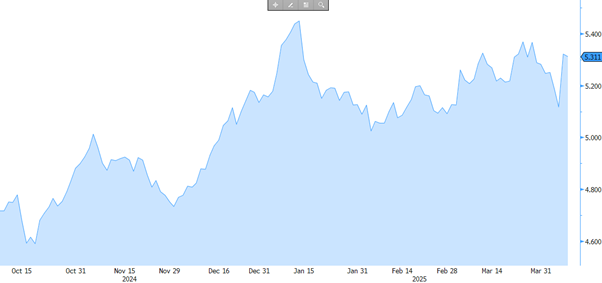
“Liberation Day” – Post Event Update
3 April 2025
Opportunity and Obstacle: Can Europe handle a stronger euro?
16 April 2025INSIGHT • 9 April 2025
A tariff tale: Britain’s partial pardon in Trump’s tariff blitz

Shane O'Neill, Head of Interest Rate Trading
Tariffs are back, but the UK’s carve-out underscores its unique positioning. Agility—not complacency—will determine the winners in this new era of economic statecraft.
President Trump's most recent act of economic brinkmanship involved reviving his trade war tactics, with a fresh wave of tariffs that rattled global markets. The measures include a blanket 10% levy on all imports, with targeted hikes on nations deemed to have particularly unbalanced trade flows. Chinese imports are subject to a 34% levy, adding to tariffs announced earlier in the year, while the EU faces an additional 20%. Though no nation avoided Trump’s wrath (even those without human inhabitants), the UK’s treatment stands out—a nuanced carve-out that reflects post-Brexit geopolitical manoeuvring.
A lucky break or temporary truce?
Unlike the EU, which faces uniform tariffs, the UK has secured partial exemptions. Key exports—luxury goods, pharmaceuticals, and financial services—remain untouched, while automotive tariffs (10%) undercut the 20% imposed on EU rivals, in addition to the 25% tariff on all foreign cars imported to the US. This divergence suggests Trump’s willingness to court Britain as a transatlantic ally, offering a potential lifeline to the UK economy.
Yet the picture isn’t entirely rosy. Steel and aluminium exports will bear the full 25% burden announced earlier this year, dealing a blow to an already beleaguered sector. The UK’s more balanced trading relationship with the US could accelerate bilateral trade talks, but any deal hinges on Trump’s willingness to negotiate, a factor that seemingly changes day-to-day.
Pragmatism over protest
Downing Street has struck a cautious tone in response to Trump, avoiding direct criticism while emphasising “free and fair trade.” The business community is divided: manufacturers warn of higher input costs (particularly for US-sourced components), while pro-Brexit factions see an opening to fast-track a US-UK pact. Although economists’ GDP estimates vary, they all agree the tariffs will weigh on UK growth, with the situation likely to worsen if global trade tensions deepen.
The Bank of England now faces a thorny dilemma. Core inflation remains sticky at 3.5% and tariffs are certain to add more price pressures, supporting the case for keeping rates higher. On the other hand, growth is set to drop materially, and job losses may soon follow, creating a strong impetus to cut rates to support the economy. This stagflationary bind is every central banker’s nightmare.
A wild ride: markets whiplashed by tariff twists and turns
Financial markets have been understandably volatile following the announcements. The pound initially climbed to 1.32 against the dollar as the greenback weakened against most pairs, but has since tumbled to 1.2755. Against the euro, sterling has also suffered. Before the announcement, EUR/GBP was trading at £0.835, but many remark that the euro could benefit from global investors diversifying away from the US dollar to the next most liquid alternative. This rhetoric has sent EUR/GBP soaring, and at time of writing it sits at £0.8580 – a rise of nearly 3% in just 3 days.
In rates markets, the initial reaction saw global yields dip as worries over weaker growth took precedence over inflationary concerns. Though short-term rate expectations have cooled slightly, markets are still pricing in one extra Bank of England rate cut this year compared to pre-Trump speech forecasts. In total, three cuts are projected for 2025, starting in May, leaving rates around 3.75% by year-end.
Longer-term yields have been even more volatile. After initially dropping post-speech, they quickly reversed all gains on Monday, making for an exceptionally wild day for bond traders. Chancellor Reeves will be watching this market closely as higher rates begin to eat into her already sparse fiscal headroom. If the gilt selling continues, Reeves may have to make increasingly difficult choices in the Autumn budget.
Figure 1: 30y gilt yields reversed all losses seen after Trump's speech - Reeves will be watching long end yields closely as higher rates eat into any flexibility her budget may have.

Source: Bloomberg
From outsider to kingmaker? The UK’s double-edged trade opportunity
In the coming months, risk managers will need to be on the front foot as political and macroeconomic headlines continue to drive markets. Bilateral trade talks will be key to the next stage of the UK’s journey: can Starmer and company negotiate a deal that maximises the nation’s position as both an EU outsider and a balanced US trade partner? Meanwhile, conditions are ripe to push for deals with all major trading partners—especially those seeking access to US and the EU—given the UK’s ability to offer the best of both worlds. Nonetheless, economic realities may pose the biggest stumbling block: with tariffs certain to weigh on growth, Reeves and her team must strike the right policy balance to shore up the economy without alienating core supporters or potential investors.
Be the first to know
Subscribe to our newsletter to receive exclusive Validus Insights and industry updates.



